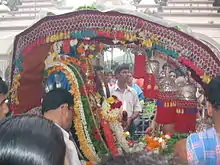Goan temple
A Goan temple is known as a dēvūḷ (देवूळ) or sansthān (संस्थान) in the Konkani language. These temples were once the centres of villages, cities, and all the other social, cultural and economic gatherings in Goa. These were known as grāmasansthās (ग्रामसंस्था) in Konkani.
History
A temple in Goa was once always the centre of a village (and in cases still is), and the lives of people were related to these temples and their festivals. The village property was divided amongst the villagers according to certain rules. The patrons of the temples are known as Mahajana and for the most part hail from Brahmin communities with a few from Kshatriya communities. This Mahajani system was once responsible for temple upkeep.
Deities

Goan temples are strictly devoted to the worship of Panchyatan devised by Adi Shankara. The following sholka says :
आदित्यं गणनाथंच देविम् रुद्रं च केशवं | पंच देवताम् इत्युक्तं सर्ववर्मसु पुजयेत् ||
The following deities constitute a Panchayatana:
- Devi ( e.g. Shantadurga, Bhagavati, Navadurga, Mahalakshmi, etc. )
- Rudra or Ishwara ( e.g.Manguesh, Nagesh, Shivnath, Damodar, Gananatha )
- Ganesh ( e.g. Mahaganapati )
- Keshava ( e.g. Lakshmi Narayana )
- Aaditya ( e.g. Surya Narayana )
In addition to these deities following deities are also worshipped.
- Kulpurush - Family Ancestor
- Ravalnath
- Bhutnath
- Gram Purush
- Kshetrapal
Architecture

All the original temples in Goa were demolished by the Portuguese, and all the patrons migrated to other places with the deity idols. The original goan temples were made of sedimentary rocks, stones, wood and limestone. Black stone built in Kadamba and Hemadpanti style were very rare. Only one ancient temple of Goa that exists is that of Tambdi Surla Mahadev. The present day goan temples are of Nagara architecture with some alterations, this kind of architecture is unique in India. When one observes, the temple can have many different angles to it, it can be perceived as a Mosque, Church or simply a Palace.
A water tank called as a Tali or a Tallay is usually seen at the main entrance of the temple. A large Praveshdwar or the main entrance, with a Nagar Khana is a very distinct feature of Goan temples. A Deepa stambha is an integral part of the temple. Other related buildings with the temple:
- Agrashala
- Bhojanshala
- Yagnya-shala
- Vahanshala
- Related offices
- Nagarkhana
The temples are usually painted in white or other light colours, and usually are covered with clay tiles. A Golden Kalasha is also seen.
The parts of the temple:
- Sabhamandapa
- Antarala
- Chowk
- Garbhagruha ( Garbhakud in Konkani )
- Sarvalli ( Pradakshina marga )
The temples have wooden carvings depicting epics like Ramayana and Mahabharata. The Garbhagruha is usually studded with silver and main idol is made of black stone and sometimes Shaligrama. Goan Konkani temples represent two murtis one is a Mula Murti to which the alankar (adornment) is usually done and which is of ancient origin and the Utsava Murti which is displayed in the temple premises. The Utsava murtis are made of silver, gold or sometimes alloys. An alloy Prasad Murti is also seen. The Chowk pillars are usually wooden with explicit carvings. The roof is also studded with paintings and chandeliers. Huge bells are hung at the entrance of the Chowk. This place is considered very sacred.
Festivals

The following festivals are celebrated in all the Goan temples:
- Jatra
- Palakhi Utsav
- Navratri
- Tarangotsav, Dasarotsav
- Samvatsar (Saunsar) Padvo
- Gulalotsav
- Shigmo
Related people
- Mahajans
- Kulavis
- Pujari
- Abhisheki (Purohits)
- Puranik
- Haridas
- Devdasi (Bhavin, Kalavant)(see: Gomantak Maratha Samaj)
- Vajantri
- Mest
- Karbhari
- Bhajak
- Mahale
See also
References
- Abram, David. Goa, 5th edition. Rough Guides, 2003, p. 110
- Gomes, Rui Pereira. Hindu Temples and deities
- Gune, Vithal Trimbak. Gazetteer of the Union Territory Goa, Daman and Diu. Goa, Daman and Diu (India) Gazetteer Dept.